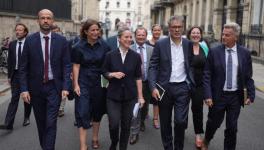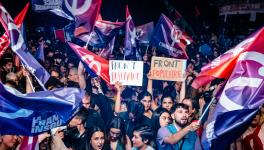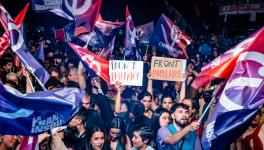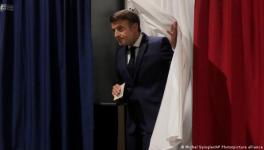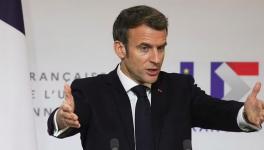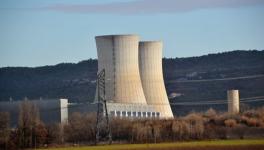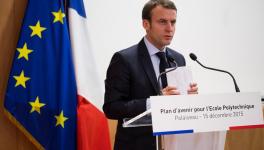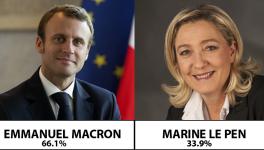The French Presidential Poll in Perspective: Prospects for the Left
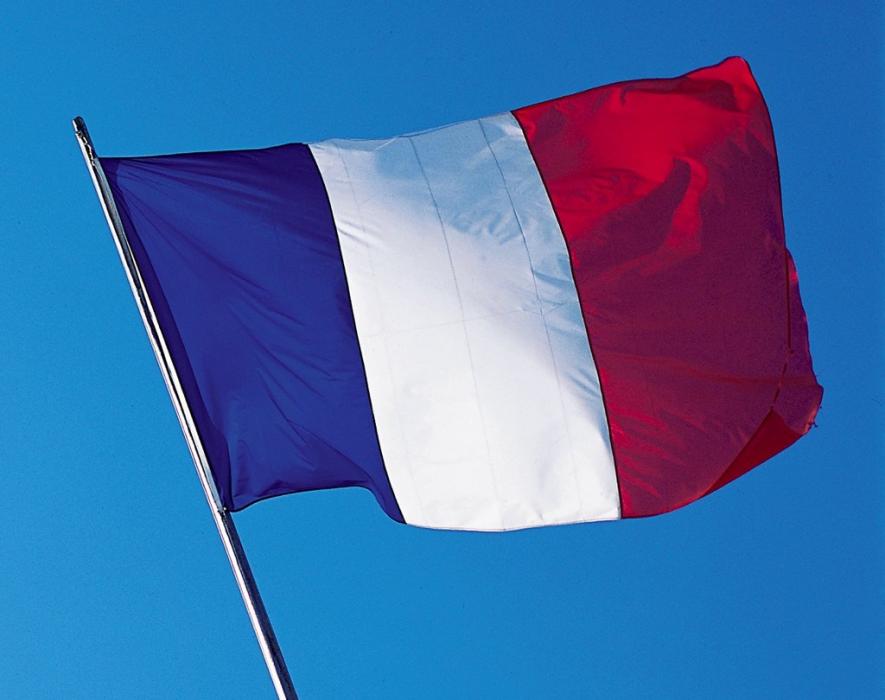
The thorough-going economic and political crisis in which France is now enmeshed (outlined in part one of this article) has speeded up and intensified processes of change within the French Left. Older organisations, including those which once exercised hegemony on the Left, have seen their influence and membership curtailed and their strategies displaced. Their decline has been matched by the emergence of new forces with a diversity of structures, strategies and goals.
For much of the twentieth century, two forces dominated the French Left: the Parti Socialiste (PS) and the Parti Communiste Français (PCF).
A classic social democratic party, the PS has its roots in the decades of demoralisation which followed the defeat of the Paris Commune in 1871. As elsewhere in Europe, French social democracy split over whether to support the national war effort in 1914 (a prominent figure on the movement’s left, Jean Jaurès, was assassinated by a nationalist fanatic just before the start of First World War). The party first won power in 1981, when its candidate, Francois Mitterrand, was elected president. Under him, the party achieved a governing majority in the National Assembly (NA), the lower house of parliament, from 1981-86 and again from 1988-93. A subsequent party leader, Lionel Jospin, served as prime minister under the right-wing presidency of Jacques Chirac (1997-2020), under an arrangement known as ‘cohabitation’. From 2002 until Francois Hollande’s triumph in 2012, governments of the Right prevailed.
The PCF was established in 1920 as the French Section of the Communist International on foundations that were firmly revolutionary and democratic centralist. In its early years, it embraced militant strike action, anti-colonial struggle and some engagement with electoral politics. It supported the anti-fascist Popular Front set up in 1936 under Léon Blum, and backed Spanish Republicans in their fight against Franco. During the Nazi occupation which followed France’s defeat in 1940, the party played a key role in the Resistance (its underground organisation, the Francs-Tireurset Partisans, became a byword for combative engagement), and by the war’s end it had become a powerful force in many parts of France. This progress was then checked by the ‘red scare’ political environment of the nascent Cold War and, in 1947, the explicit exclusion of the PCF from government.
Paradoxically, party prospects improved following the founding of the Fifth Republic in 1958 (a step the party had opposed). Emerging from its isolation, it made rapprochements with other left-wing forces and increased its strength in parliament. Under the leadership of George Marchais, in 1973 the PCF forged a common programme alliance with Mitterrand’s reconstituted PS – but soon found itself losing ground to its wily partner. In 1977, a meeting between Marchais and the leaders of the Spanish and Italian communist parties at Madrid laid out the framework of Eurocommunism, an ill-fated attempt by European communists to achieve Gramsci-style hegemony by differentiating themselves from the Soviet path.
In the event, nothing seemed able to stem the long-term decline and shrinking membership of the PCF, once the strongest communist party in Western Europe. After a particularly poor electoral showing in 2002, it began seeking broader social alliances while closing ranks behind its local elected officials.
The rise of Jean-Luc Mélenchon, currently the most prominent figure on the French Left, should be viewed in this historical context. In his youth a Trotskyist, Mélenchon joined the PS in the 1970s, becoming one of the party’s youngest senators. Despite his close links with Mitterrand, during the 1980s and 1990s he consistently aligned himself with the party’s left-wing. His three terms in the Senate and the fact that he held ministerial office for two years during Jospin’s ‘cohabitation’ with Chirac, have contributed to his standing as a savvy and experienced political player.
In 2005, Mélenchon’s longstanding problems with the PS, in particular its embrace of neoliberalism, came to a head in the context of a national campaign against the European Constitutional Treaty. Mélenchon joined the mobilisation against this bid to ‘constitutionalise’ the European Union’s neoliberal agenda, for example by committing member states to “free and unfettered competition in the market”. Two years later, he left the PS to form his own organisation, the Parti de Gauche (Left Party). This in turn joined forces with the PCF and some other organisations to create what was known as the Front de Gauche (Left Front). Mélenchon ran for president on this platform in 2012, garnering four million votes (roughly 11 per cent of ballots cast).
This period also saw the arrival of other new forces on the left, in particular the reconfiguration of the Ligue Communiste Revolutionnaire (LCR), a key element in the historic Paris events of May-June 1968. Under the leadership of Olivier Besancenot, a postal worker of impressive organisational ability and personal charisma, the LCR had put up a strong showing in the elections of 2002 and 2007. Early in 2009 it dissolved itself into a fresh formation, the Nouveau Parti Anticapitaliste (New Anticapitalist Party) (NPA), in a bid to unify the fractured anti-capitalist Left and attract new activists.
The failure of both the Left Front and the NPA to achieve a breakthrough in terms of their respective goals contextualises recent development on the Left, in particular the ascent of Mélenchon’s new movement, La France Insoumise (LFI) (France Unbowed, or Insubordinate France).
Launched in February 2016, LFI set itself the goal of getting Mélenchon elected president in 2017 and deputies elected to the national assembly in the subsequent legislative elections. This was to be done on the basis of a programme, L’Aveniren Commun (Common Future), and a loose organisational structure that would be more movement than party. In making this shift, Mélenchon was clearly influenced by developments across the Spanish border, in particular the gains made by Podemos.
LFI’s programme, structured in terms of seven axioms, seeks to set France on a new course, underwritten by radically different political-constitutional arrangements (a Sixth Republic, more open and democratic, to replace the top-down, arthritic Fifth Republic) and a radical shift away from austerity to wealth redistribution, including no-holds-barred taxation of the rich. Building a people-oriented economy is seen to demand a renegotiation of France’s treaties with the EU (Plan A), in the absence of which Plan B – withdrawal from EU membership – will be effected. The programme calls for the repeal of labour ‘reforms’ imposed by decree during Hollande’s car crash of a presidency; raising the minimum wage; the creation of a public banking centre; the implementation of an energy transition plan towards renewable energies and the phasing out of France’s nuclear power plants; and the establishment of a “green rule” by which nature may not be deprived of what it cannot replenish. Other proposals include withdrawing from NATO; reinforcing the 35-hour week and moving towards 32 hours; and reducing the retirement age from 62 to 60.
It was on the basis of this programme, transmitted to voters by networks of committees, three thousand supporters’ groups and battalions of foot-soldiers as well as by Mélenchon’s indefatigable and mesmerising campaigning, that LFI thrust its way into the 2017 presidential campaign with rocket-like impetus. From a starting point close to his 2012 tally of 11 per cent, Mélenchon pursued an upward trajectory of apparently unstoppable momentum. Aided by his impressive performance in televised debates and LFI’s adept use of social media, his popularity ratings soared. Thousands flocked to mass rallies where, in the absence of the leader himself, his hologram would thrill the crowd. By the final stages of the campaign, the possibility of his propelling his way into the second round was generating enormous excitement within Left circles at home and abroad, while triggering the alarm of global finance. In the event, Mélenchon came within 650,000 votes of entering the second round, establishing a record for France’s anti-capitalist left by winning 19.6 per cent of the first round ballot and the support of more than seven million voters.
A major achievement of Mélenchon and his movement over the frenzied weeks of the presidential campaign was to draw significant numbers of working-class and young voters away from the fascist Front National. LFI also attracted support from France’s beleaguered minorities, with 37 per cent of Muslim (by religion or culture) voters opting for Mélenchon (against just 24 per cent for Macron). The readiness of the most oppressed in French society to get behind the LFI leader, despite his inability thus far to break with the notion of ‘laïcité’ – an ultra-secularist position which, long detached from its revolutionary, anti-clerical origins, is now being weaponised against France’s Muslim population – is encouraging.
As political France prepares for the two-round legislative elections to be held next month, Mélenchon’s movement will be seeking to build on its gains, continue the anti-fascist fight, and establish a significant bridgehead within the national assembly. Meanwhile, other forces on the Left, reaching beyond the PCF and the NPA to include the high school students whose protests against the pseudo-choice between Macron and Le Pen, austerity and fascism, recently forced school closures across France, will also be preparing for further action.
Disclaimer: The views expressed here are the author's personal views, and do not necessarily represent the views of Newsclick.
Get the latest reports & analysis with people's perspective on Protests, movements & deep analytical videos, discussions of the current affairs in your Telegram app. Subscribe to NewsClick's Telegram channel & get Real-Time updates on stories, as they get published on our website.









